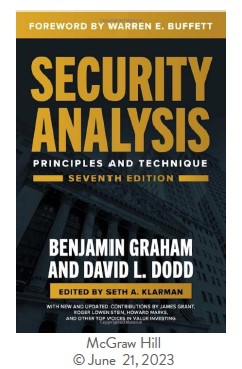
This is how Seth Klarman, the well-known Boston investor, describes value investing. Benjamin Graham pioneered value investing with the publication of Security Analysis in 1934. His style emphasizes rigorous fundamental analysis of a company to determine its real value independent of its stock market price, waiting for an entry level that ensures a margin of safety, maintaining a long investment horizon, and finally, staying patient to see out stock market declines.
I would wager that very few investors have actually read Security Analysis in its entirety. Graham was writing in the 1930s and many of his examples, including references to smokestack industries, railroad bonds, and an emphasis on book or liquidating value, are simply not as relevant today. But what makes Security Analysis still valuable is that it gives us a set of investment principles which are enduring and which we can use to look at our current environment.
Seth Klarman edited the seventh edition of the Graham and Dodd classic. He enlisted 11 Wall Street professionals to provide a commentary on the original text. The contributors invest in very different asset classes (stocks, distressed debt, private equity, international, arbitrage, etc.) but they all follow, in their own way, a value strategy. The commentaries, bringing the past to the present, are what make this new edition so valuable.
Value is just one style of investing. There are others, including growth, momentum, technical analysis, and market timing. What appeals to us about value is it is a conservative, sensible approach based on facts, not the vagaries of market fluctuations.
In our very first newsletter, September 1995, we gave two reasons for why value works. The first is, investors don’t like going against the grain, and they especially don’t like investment losses. When their stocks drop, they sell, which often pushes the price down to a level below where it ought to be based on the fundamentals. This creates an opportunity for value buyers who are not afraid to step away from the crowd and make their own independent decisions. This idea remains sound today.
The second reason justifying value is that regression to the mean is a powerful force, and eventually, cheap stocks revert back to the mean and expensive stocks get cheaper. This idea has not played out as well or as consistently as it used to. Regression to the mean works in some instances but not in all.
We still are value investors who adhere to Graham’s principles, but value investing has changed and gotten harder. When Graham was writing, studying the balance sheet of a company was of greatest importance. You could identify a firm’s liquidating value, buy well below this, and wait for the stock price to eventually revert to the mean.
But things are not so simple today. The world has changed since the 1930s. Studying the cash generating ability of a company, not its balance sheet, is now the most important thing, along with making a best guess about the future course of a business. Graham had no interest in looking at a company’s future because it was unknowable, so he just looked at the current facts. But we have no choice but to consider the future. It is interesting that the word ‘‘technology” was not listed in the index of the first four editions of Security Analysis. But technology today is often all-powerful, creating whole new industries and destroying others. Value investors, and we include ourselves here, have at times gotten too enamored with “cheapness’’ and missed the point that technology and competition can change the world quickly. Cheap stocks often deserve to be cheap.
So how do we determine whether a stock is ‘‘just cheap’’ or ‘‘good value’’? Unfortunately, there is no formula. It is a combination of art and science. One idea I like comes from Warren Buffett. Imagine when you buy a stock that trading will be stopped for five years. You are locked in. Now you have to decide, is this company, its industry, and present management team one that can survive and thrive the next five years? Or will it be disrupted and overtaken? You will think longer and harder about your investments using this technique.
In baseball if you hit .350 over your career you will get into the Hall of Fame. But this also means you have made outs six out of ten times. Investing is an equally humbling exercise, as Klarman points out. The secret is there is no secret. The best investors stay deeply curious, intellectually honest, and continuously retest their beliefs and change their opinion when the facts change. And most important, they are patient and long-term in their thinking. Keep in mind the old adage, get rich slowly.